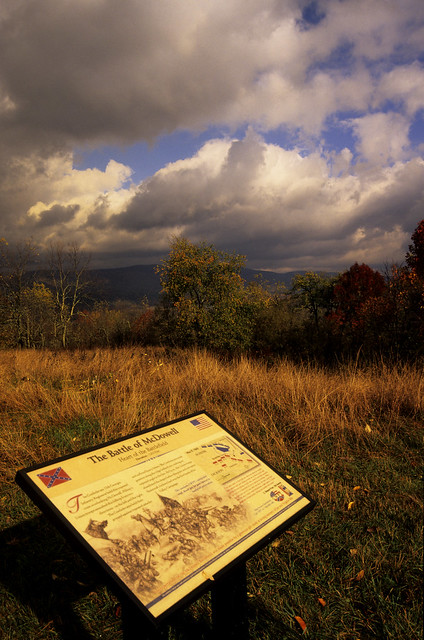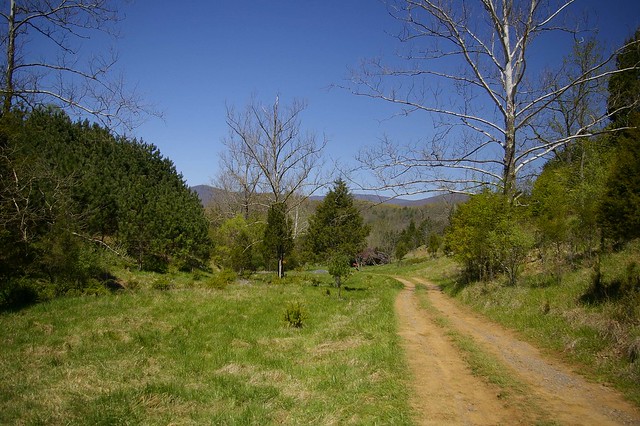 |
| Johnston |
On the morning of May 8th, 1862, Jackson's Army of the Valley resumed its march at an early hour with Allegheny Johnson's troops in front. They were advancing towards the small town of McDowell, where Union general Milroy was positioned. Milroy was greatly out numbered, but a another brigade under Schenck was on the way which would even out the odds. At 10:00 AM, the Confederates reached Bull Pasture Mountain, and Johnson ordered his men to climb up a ravine to the top of Sitlington's Hill which overlooked the enemy camp in McDowell. Sitlington's Hill was a rocky hill covered in forest and boulders at the top of which was an open field.
 |
| Milroy |
When Milroy spotting the Confederates he ordered 4 companies of his troops to climb the hill and engage them. He ordered the artillery to open as well, but that was impossible because they could not elevate sufficiently to reach the top of the hill. The Union troops failed to drive off the Confederates in the ensuing skirmish, and Johnson's division continued to deploy, regiment by regiment, as they reached the crest of the hill. The center of the line was held by the 12th Georgia, Johnson's old regiment. The Confederates tried to bring cannon up the hill, but that was a difficult chore, so Stonewall Jackson decided not to drag them up because they would not do much damage, and they could easily be captured. Neither side was able to use its artillery in this battle.At 10:30, Schenck arrived at McDowell. He outranked Milroy, but allowed him to remain in command since he was familiar with the situation. The Union artillery on an adjoining hill opened on the Confederates, who laid down to find cover behind rocks and trees. Milroy decided to attack when he was told that the Confederates were putting cannon on Sitlington's Hill. This was not true, but if it was it would have meant the Federals would have to immediately retreat. Milroy decided to launch an attack to stun Jackson so that they could safely retreat.
 |
| Picture via Civil War Trust |
Sitlington's Hill was a very strong position. It was very unlikely to be captured by a frontal attack, especially since Milroy was outnumbered by the Confederates. Nonetheless between 4 and 5 pm, two regiments from Ohio, totaling 900 men, went forward. They crossed Bull Pasture River at the foot of the mountain then climbed up a ravine. When the troops reached the top, tired from their long climb, the Confederates opened a musketry fire on them. Suddenly the outnumbered Northerners charged, surprising the Confederates, and pushing all of the first line of regiments back except the 12th Georgia. They stayed in position, and even when the officers ordered them to the men refused to go, saying,"We did not come all this way to Virginia to run before Yankees." This one regiment in front of all the others soon was flanked on both sides. The Confederate line formed into a V, and the 12th Georgia at the point was being fired on from three sides. When the Federal troops moved past the 12th Georgia and hit the 2nd Confederate line, their success did not continue. The line consisted of three of Johnson's regiments under Col W. C. Scott. Scott rode along his line, keeping his men in position. The Confederates had a strong position. They had built breastworks out of trees and brush, so that they could fire at the Unions without showing anything more than their heads. The Federals held their ground under a heavy fire by superior numbers for 90 minutes.

Although Milroy had originally intended to only launch one attack and then retreat, the two Ohio regiments had made more progress than he had expected. He decided to reinforce them with two more Ohio regiments and another from West Virginia. He sent them to try to hit the Confederate right flank. They marched along the turnpike to the North of Sitlington's Hill. The Ohio regiments found a ravine and climbed to the top of the hill. The Confederates were surprised to see the Federals coming up through the woods on the their flank, as they came forward with a sudden bayonet charge. The line was bent back, but then the Confederates counterattacked, and after heavy back and forth fighting the Unions were driven back. A Confederate captain later wrote this about the battle:
"The whole scene is yet vivid in my mind as I saw it. There was a kind of horrible grandeur about it all that allured and inspired some, and struck others with trepidation. ... Reinforcements are now entering on the Federal side with battle shouts and huzzahs, which are answered in grim defiance by the Confederates. ... On we go up the Ridge, take our position in line and open fire on the enemy. The battle now rages ten times fiercer than before, men fall on every side, some never to rise, while others are wounded and helped to the rear. The smoke of battle settles upon us so dense and dark that we cannot see happenings around us. Begrimed, drinking and tasting the smoke of battle seemed to increase courage and determination, and thus with defiant war cries the battle goes on for some hours. Nightfall came upon us, yet the battle still went on in unabated fury."
By this time the sun was beginning to set, and the Confederate line on the top of the hill held firm, anchored by the 12th Georgia. One of the problems for the Confederates was their high position. It accentuated the propensity of new troops to shoot high, and so most of their shot went through the trees above the heads of the Federals, or hit them in the head. After the battle the Northerners remembered being covered with bark and branches falling from above cut by Southern bullets. At this time, Allegheny Johnson was wounded while commanding his troops. He was shot in the ankle around 8 pm and Taliaferro, Jackson's third brigade commander took over. The fighting continued until at 8:30. Then, the Federals fell back having used up all of the 60 founds of ammunition they had been issued, and not being able to be supplied as the wagons could not come up the hill. Milroy authorized a retreat, saying that the purpose for the attack had been fulfilled. He had been told by deserters that Jackson had 20 cannon and was expecting reinforcements. However, throughout the war many deserters exaggerated or bluntly lied. Sometime false deserters were sent, but many times although they were tired of fighting, they still wanted their country to win, so would give false information.
 |
| Picture via Civil War Trust |
The Confederates suffered 116 killed, 300 wounded and 4 missing. Most of these were from Johnson's troops, and the 12th Georgia had the most casualties because of their refusal to retreat, leaving them at the frontmost point. the federals had 34 killed, 220 wounded and 5 missing. The Confederates had more than twice as many casualties as their opponents. This was because most of their bullets went over their targets. The Unions were lower and tended to shoot more accurately, and the setting sun silhouetted the Southerners on the ridge.
During the night, Milroy retreated, and the Confederates captured the supplies that they had left. Jackson a simple message to Richmond saying, "God blessed our arms with victory at McDowell yesterday." A few days later he issued this congratulatory order to his men:
"Soldiers of the Army of the Valley and Northwest:
I congratulate you on your recent victory at McDowell. I request you to unite with me this morning in thanksgiving to Almighty God for thus having crowned your arms with success, and in praying that He will continue to lead you on from victory to victory, until our independence shall be established, and make us that people whose God is the Lord. The chaplains will hold divine service at ten o'clock A.M. this day in their respective regiments."







0 comments:
Post a Comment